 George Keremedjiev
George KeremedjievSensor Excellence at Tower Automotive
October 1, 2011Comments
I rarely witness stamping tooling as beautifully and thoroughly sensored as what I recently spied at the Tower Automotive facility in Bardstown, KY. All too often I see transfer tooling with sensors only mounted on the transfer arms. But what about the monitoring of parts as they release from the gripper fingers? Often these parts tend to take on the characteristics of airplane wings, floating down to their respective die sections. Just how does one know if the parts seat (nest) properly within the lower tooling? And how do you know that the parts are properly placed on the lifter? Well, the folks at Tower Bardstown have answers to these questions, thanks to the use of sensors mounted deeply within its transfer and progressive tooling.
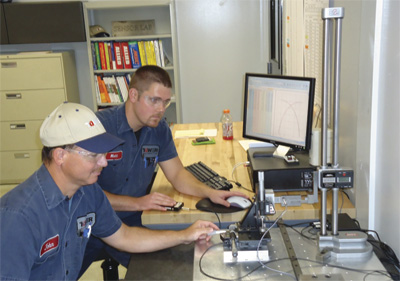
Sensor-applications specialists John Moore and Matt Reynolds test sensors in the Tower Automotive error-proofing laboratory.
It all starts with an unwavering plant-management commitment, spearheaded by plant manager Shawn Callahan and his managerial and technical staffs. Callahan appointed two full-time people to serve as sensor-application specialists, tasked with developing an error-proofing laboratory. They meet weekly with an error-proofing technology committee and to implement, along with the assistance of the toolroom and tool-engineering departments, electronic sensors throughout the plant’s numerous existing and future progressive and transfer tools.
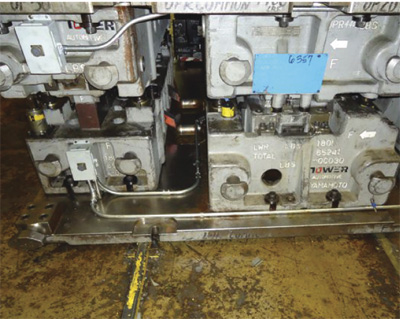 |
| Electrician’s conduit, with the appropriate fittings and mounting hardware, protects the sensor wiring. |
The plant’s sensor-applications specialists: John Moore, a 21-yr. veteran of the tool-and-die-making profession with Journeyman Toolmaker credentials and an Associates Degree in Machine Tool Technology; and Matthew Reynolds, a graduate of the Tower Tool and Die Apprenticeship Program and who also boasts an Associates Degree in Machine Tool Technology, along with an Associates Degree in Business Management. Moore, Reynolds and their team began their die-sensoring efforts by focusing on a transfer tool with more than two dozen sensors located throughout the upper and lower sections. The sensors ensure that, among other monitored events, parts are placed properly on lifters before the press is allowed to close. Previously, the tooling would all-too-often mash parts and/or crash the sections where the parts—once released by the transfer mechanism—did not land on their assigned lifters and/or did not properly nest within the lower sections. Since adding the sensors, the transfer tooling runs faster and unattended, as the operator no longer needs to nervously patrol the process.
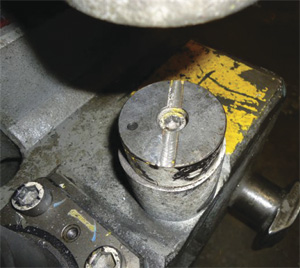 |
| An electronic sensor mounted within a stop block monitors shut height. |
A key to the sensor-program’s success is the thorough bench testing of sensors in the error-proofing laboratory. The days of testing sensors only on the shop floor during production runs are over at this facility. And, Moore and Reynolds work closely with the plant’s die engineers to ensure that appropriate wiring channels and mounting details are designed into new tooling, rather than implementing sensors as an afterthought.
During one of my visits with this exemplary company, I was struck by the positive attitude exhibited by the press operator as she watched a set of tooling run under the full protection of electronic sensors. What could be more satisfying to the operators on the shop floor, as well as to those in upper management, than to witness smooth-running presses and tooling? MF
Technologies: Quality Control, Sensing/Electronics/IOT
Comments
Must be logged in to post a comment. Sign in or Create an Account
There are no comments posted.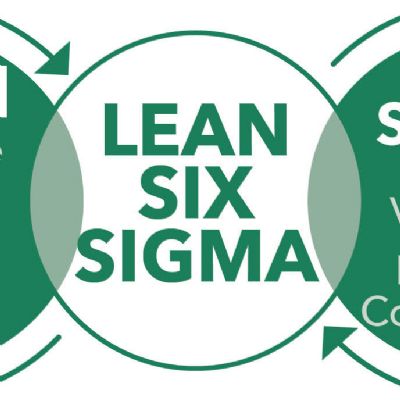 Management
ManagementUse Lean Six Sigma for Efficiency & Quality Improvement
Daniel Schaeffler Friday, October 27, 2023
Seeking Small Victories: Continuous Process Improvement
Daniel Schaeffler Monday, September 25, 2023
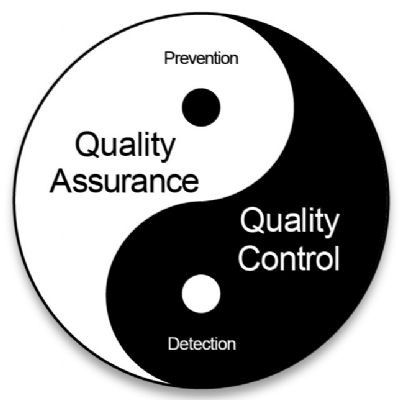 Quality Control
Quality ControlAn Introduction to Quality Management Systems
Daniel Schaeffler Thursday, July 27, 2023
 Quality Control
Quality ControlIn-Process Inspection Software Provides Real-Time Visibility
Tuesday, March 28, 2023





